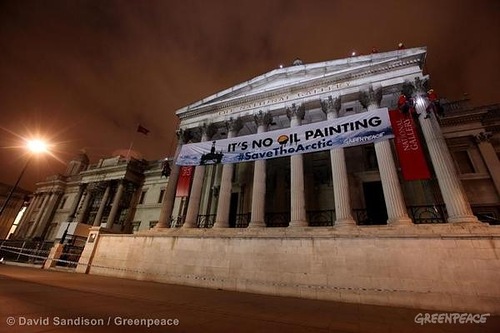Environmental organization Greenpeace is 40
Greenpeace is 40
Formed from the peace movement and anti-nuclear protests Greenpeace appeared in Vancouver (British Columbia) in the late 1960s and early 1970s. Besides, September 15, 1971 the newly created Committee «Don’t Make a Wave» sent a chartered ship «Phyllis Cormac» route from Vancouver to Amchitka (Alaska). And later the ship renamed «Greenpeace», protested against nuclear tests in earthquake-prone areas. In particular, protests of environmentalists forced the U.S. government to stop testing at Amchitka area and by the end of 1971 the island became a bird sanctuary.
Tcktcktck and Greenpeace volunteers raise a wind turbine on the beach at dawn in Durban, South Africa. Campaigners say Durban must be a new dawn for the international negotiations to agree a fair. Ambitious and legally binding treaty to avert climate chaos. They are demanding that politicians stop listening to the polluting corporations and listen to the people who want an end to our dependence on fossil fuels. Africa is on the front line of dangerous climate change, with millions already suffering the impacts through increased drought and extreme weather events, threatening lives and food security.
East Asia Taipei office released the hot air balloon at Dr. Sun-yat Sen Memorial Hall. Greenpeace urges the Taiwanese Fisheries Agency and other Asian fishing powers to protect the Pacific and its valuable tuna populations in the upcoming Western and Central Pacific Fisheries Commission (WCPFC) meeting in Guam later in March (3/25-3/30).
Campaigners climb the National Gallery in Trafalgar Square and hang a large banner from the front of the building. Shell are holding a prestigious event at the gallery with many influential and important people attending. Greenpeace is making sure these people know about Shell’s plans to drill for oil in the Arctic.
Greenpeace is 40

Coal is killing the reef. Dr John ‘Charlie’ Veron dive for an underwater protest in the Great Barrier Reef and place a banner reading “Coal is killing the reef”

Kumi Naidoo, Executive Director of Greenpeace International, helps hold a banner at the front of a march with community activists near the Fisk Coal Power Station in a Moving Planet global day of action

Castor Transport Action in Germany Castor-Protest against the Castor nuclear waste transport to the interim storage Gorleben. The banner reads: Phase out Gorleben – Castor Stop

Action at Asheville Power Station in US. The Progress Energy owned Asheville Power Station uses the most destructive form of coal mining, mountain top removal, which is flattening mountains across Appalachia

Actor Lucy Lawless joins Greenpeace New Zealand activists in stopping a Shell-contracted drill-ship from departing the port of Taranaki for the remote Arctic, where its exploratory oil drilling program threatens to devastate the Alaskan coastline

calling on the ASEAN to divert from the nuclear path it laid down in the Treaty of Bangkok and repeal the nuclear development provision in the ASEAN Energy Cooperation Plan for 2010-2015

The pirate fishing vessel. Greenpeace activists chase an illegal, unregistered and unlicensed (IUU) purse seine fishing vessel on the high seas, close to the border with Indonesia’s Exclusive Economic Zone (EEZ), 24 November 2011
www.greenpeace.org/international












